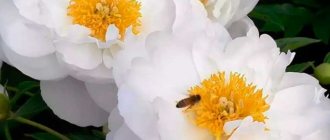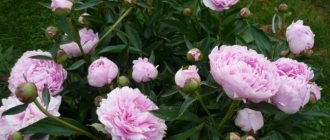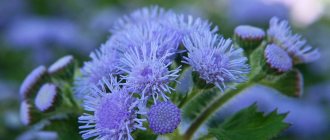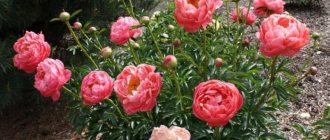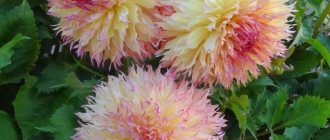History of selection
Paeonia Karl Rosenfield belongs to the herbaceous species. Developed in China, it is sometimes heard referred to as Rosenfield. In its homeland, it gained such popularity that it served as a decoration for the national emblem. Also, images of this peony are often used to decorate fabrics, not only in China, but also in Japan.
Peony Karl Rosenfeld from China has spread throughout the world
Thanks to its spectacular appearance and ease of care, the Karl Rosenfeld variety is loved by flower growers. Moreover, this southern plant feels good in a fairly cool climate. Peony will not be able to take root except in the Far North.
Peony Yellow Crown (Paeonia Itoh Yellow Crown) - what kind of variety is it
The creator of the new hybrid is a scientist from the land of the rising sun, T. Ito. The ancestors of the newcomer were tree and herbaceous peonies. Since then, golden peonies began their triumphal march throughout the world.
Yellow peony
For your information! Yellow Crown Peony (another name for Bartzell peony) is created on the basis of two different species, so it does not look like either of them.
The new plant is characterized by many years of development in one place. Over the years, the bush becomes more voluminous. If the location is chosen well, the crop will be annually covered with a cap of yellow buds.
For propagation purposes, it is recommended to use the rhizome of a young bush. It is better not to touch a plant older than 4 years. By this age, the roots turn to stone and cannot be cut.
Brief description and characteristics
Yellow peonies are quite tall. An adult plant grows to almost a meter. The entire above-ground part (stems, leaves) of the hybrid is dark green. With the onset of frost, it dies off (the influence of the herbaceous peony species). Bright yellow buds are double and semi-double, at least 18-21 cm in diameter.
Mature peony bush
Advantages and disadvantages of the variety
The advantages of the ITO hybrid include:
- lush flowering;
- disease resistance;
- frost resistance;
- wonderful aroma;
- decorative throughout the growing season.
Disadvantages of the variety:
- the location of the buds among the leaves where they are not visible;
- the appearance of non-double flowers;
- change in color and appearance of patterns on the petals;
- high cost of seedlings.
Description of peony Karl Rosenfeld
The bush of the Karl Rosenfeld variety is powerful, reaches a height of 1 m, spreading. The leaves are carved and have a light olive tint.
The leaf plate on the surface is smooth, with a noticeable shine. In autumn, the bush turns red, which allows the Karl Rosenfeld peony to remain decorative all season.
Basically, the plant has gained such popularity due to its lush and bright flowers. The peony will show all its beauty when planted in open sunny places. The shoots and peduncles are quite strong, dense and able to withstand the weight of large buds.
Inflorescences up to 20 cm in diameter, double, brightly colored. Most often you can find Karl Rosenfeld in ruby or purple tones, but there are options with rich red, soft pink and white flowers.
It is not necessary to tie up the bush, but many gardeners use decorative supports because the peony is quite spreading.
The surface of the leaf is smooth, with a visible shine. At the end of summer, the crown acquires a reddish color and remains that way until late autumn.
The advantages of peony Karl Rosenfeld are as follows:
- cold resistance;
- tolerates drought well;
- resistance to most diseases and pests;
- large bright double flowers;
- pleasant aroma;
- ease of care.
The disadvantages include the high cost of these peonies, as well as the loss of varietal characteristics when propagated by seeds.
Peony bloom Karl Rosenfield
Peony Coral Charm (Paeonia Coral Charm) - features of variety propagation
Subject to a number of conditions and proper care, the Karl Rosenfield peony begins to bloom in 2-3 years. Flowering duration is 2-3 weeks. Description of the blooming bud:
- flowers are simple and semi-double, solitary;
- the diameter of dense inflorescences is about 18 cm;
- the color scheme is varied, you can find a bright red bud with a purple tint, white and pink; often come across bright pink with a red tint;
- the edges of large petals are curved and wavy.
Note! During the first flowering period, 1 bud remains, the rest need to be cut off. This will help strengthen the next shoots, and subsequent flowering will become more luxuriant.
Period of activity and rest
Activity begins around early or mid-April. Lactiflora Karl Rosenfield attracts attention before frost. The dormant period lasts from November to March.
Care during and after flowering
Features of using fertilizers:
| Month | Period | Fertilizers | |
| 1 | April | First shoots | Nitrogen-containing 70 g per bush |
| 2 | May June | Buds appear | Bucket of bird droppings or mullein solution |
| 3 | July August | End of flowering | Phosphorus-potassium |
| 4 | September | Add 50 g of superphosphate to 10-15 kg of humus | |
| 5 | October | Preparing for rest | It's good to dig up the ground. Mix 30 g of phosphorus-potassium fertilizer with 15 kg of compost or rotted manure |
Preparing for the dormant period in autumn
What to do if it doesn’t bloom, possible reasons
The crop may not bloom in due time for the following reasons:
- little light;
- a lot of moisture;
- the plant has been exposed to diseases and pest attacks;
- thin soil layer or insufficient nutrients.
To correct the situation, you need to find out the cause. If diagnosis and elimination do not help, the peonies are transplanted.
On a note! After re-transplantation, the plant will bloom in 2-3 years.
Application in design
The herbaceous peony Karl Rosenfeld is very popular among landscape designers. Bright, beautiful flowers look great in many compositions. But here you need to carefully select your neighbors.
The recommended placement scheme for the Karl Rosenfeld variety is to place 4-5 bushes in the middle of the flower garden, with ground cover crops around them. Peonies look good with hybrid tea roses, which bloom a little later and look great against the background of reddish foliage.
Karl Rosenfeld is also used in the formation of mixborders. In this case, decorative onions, mantles and garden geraniums will be good neighbors. In flower beds, peonies are combined with Siberian iris, sedum and common chinstrap.
Attention! Herbaceous peonies should not be planted with plants of the Ranunculaceae family, as they deplete the soil and will not allow large flowers to bloom normally.
When placing the Karl Rosenfeld variety in the composition, it is worth considering its main properties:
- it is a bright spot that attracts attention;
- requires open sunny areas and fertile soil;
- can grow in one place for 15 years;
- a spreading bush requires enough space.
Karl Rosenfeld is one of the main accents of any composition, regardless of its neighbors.
With the correct selection and proper placement of plants, you can get a flower bed that blooms from early summer until the last days of autumn.
Growing a flower, how to plant it correctly in open ground
To grow healthy, abundantly flowering bushes, you need to follow certain simple rules.
Planting with root cuttings
Root cuttings are sections of the rhizome, 2-5 cm long. The cutting must contain at least 1 bud and root. Planting material is harvested in July-August.
The procedure is as follows:
- Carefully remove the rhizome from the ground.
- Divide the rhizome into cuttings.
- Disinfect the cuttings by soaking them for 2 hours in a pink solution of potassium permanganate.
- Dry the planting material, sprinkle the sections with crushed coal
- Plant the cuttings in the prepared holes at a distance of 15 cm from each other.
The plot with cuttings is shaded from the sun, regularly watered, weeded, and mulched for the winter. The first flowers on the plants will appear after 3 years.
Important! In the first two years after transplantation, all buds on the bush are cut off. This is done to stimulate the growth of the root system, which could ensure lush flowering.
What time does boarding take place?
The best time for planting peonies in open ground is considered to be the last week of August - the first week of September. When planting seedlings during this period, you can be sure that they will take root and form a good root system.
Selecting a location
Since the Ann Cousins peony grows in one place for up to 30 years and does not tolerate transplantation, the choice of its place of residence must be taken responsibly.
Main characteristics:
- open, sunny place;
- the soil is nutritious, loose;
- groundwater on the site should not be close;
- high-quality drainage must be ensured;
- absence of other perennials and buildings nearby.
Important! Ann Cousins peony will not bloom in the shade
How to prepare the soil and flower for planting
Preparing the landing site:
- Dig a hole 60 cm deep and 60 cm in diameter;
- Place at least 15 cm of drainage at the bottom. You can use pebbles, brick chips, and expanded clay.
- Place a layer of soil with humus on top of the drainage.
After 1-2 weeks you can plant a new bush.
Plant preparation:
- All stems of the selected plant are cut off.
- Carefully dig out the root system, trying not to damage the adventitious roots.
- The soil is removed from the roots so that the buds become visible.
- Adventitious roots are cut off, leaving 10-12 cm.
- Rotten, dried sections of rhizomes are removed by sprinkling the sections with crushed coal.
- The rhizome is divided into parts using pruning shears or a sharp knife so that each plot contains 2-3 developed buds and 2 adventitious roots.
Important! It is not recommended to divide or replant a plant younger than 3 years old.
Step by step landing procedure
Planting a peony is not difficult, but it is necessary to follow the algorithm.
Procedure:
- The rhizome section is placed in a prepared and well-watered hole.
- The upper bud is placed level with the ground surface.
- Fill the hole with soil, compacting it.
Finally, the planting site is mulched with hay and sawdust. Watered.
Planting with seeds (for selection)
Obtaining Paeonia Ann Cousins seeds is a troublesome task; many hybrids do not bear fruit at all. The peculiarity of seed propagation of the Ann Cousins peony is that its seeds are difficult to germinate. Only every fifth or sixth seed planted germinates. A bush grown from a seed will bloom only 6-7 years after planting.
Seed collection is carried out in August, when the boxes have just begun to open. The seeds are planted in a container with calcined wet sand.
For preparation, a two-stage stratification is carried out.
- Warmth. Wet sand with seeds is heated twice to +30 °C. After heating, the sand is cooled to room temperature and watered.
- Cold. Seeds germinated in sand are transferred to peat pots. Seedlings are kept for 3 months at a temperature of +5+10 °C.
After stratification, young peonies are transferred to a room where they live until May, when they can be transplanted into open ground.
Proper planting of peony is the key to abundant flowering
Reproduction methods
Peony Karl Rosenfeld can be propagated in two ways:
- Dividing the bush.
- Seeds.
The second method is quite labor-intensive, and flowering can only be expected in the 4th-5th year, and there is no guarantee that the varietal characteristics will be preserved.
Dividing the bush is the simplest and most effective propagation method. Flowering can be observed already from the second year, after planting. It is recommended to divide an adult bush at the end of August. Each part must contain at least three buds, from which flower stalks and an intact tuber will appear. To protect the cut site, it is treated with ash or brilliant green.
Description of the variety
We recommend that you read
Peony Karl Rosenfeld belongs to the lactoflora species and has large fleshy root tubers. The height of an adult plant varies from 85 to 100 cm, but the main notable feature of the peony is its flowers. Karl Rosenfeld's are amazing. Terry, very large and bright, these flowers will not go unnoticed in any garden plot. Their shade is varied - from ruby to red-violet.
The petals of this peony are beautiful individually. Each of them is quite large, wavy, but thin. Another advantage of the flower is its aroma - sweet, but not cloying and unobtrusive.
This peony will decorate any area. With its help, you can decorate individual flower beds or create large compositions with the participation of other plants. It will be in place everywhere, because thanks to its rich color and large size the plant looks like a king.
Planting and care
For successful cultivation and full flowering, the lactiferous peony Karl Rosenfeld requires the fulfillment of certain conditions:
- Illumination - you need to choose an open place and make sure that there is access to the sun's rays, but protection from drafts and strong winds is important.
- Soil - loamy or sandy loam soils are ideal. It is worth considering that flowers will appear earlier on sandy substrates, but their decorative qualities will be worse.
- Humidity - the main thing is to ensure good drainage and avoid stagnation of water. In soils prone to waterlogging, when planting in lowlands, the roots will most likely begin to rot.
Peonies are planted by Karl Rosenfeld in the last days of August or the very beginning of September. Planting dates directly depend on the weather conditions of the growing region. In cold climates, peonies are planted in the third ten days of August, in the middle zone - in early September, and in the south - in the first ten days of October.
Before planting, the tubers are kept in a solution of potassium permanganate, then the existing sections are treated with ash.
Seedlings must be selected that are strong and without external damage. The tubers should be quite dense. You need to make sure that there are at least four buds, then flowering will be early. Long roots are cut to approximately 15 cm.
Algorithm for planting herbaceous peony Karl Rosenfeld:
- Make a hole measuring 50x50 cm.
- At the bottom there is a drainage layer and nutrient soil.
- Compost, ash and superphosphate are added to poor soil.
- The roots of the tuber are straightened and distributed along the bottom of the hole.
- Next, the plantings are covered with earth, each layer must be compacted.
- Then water and mulch the soil.
- If there are several bushes, maintain a distance of 1 m between them.
- The flower bud is buried 4-5 cm.
Important! The herbaceous peony is not suitable for placement in flowerpots or in an apartment due to its considerable size.
Peonies after flowering
The end of the flowering period is not a reason to relax. It is worth continuing to care for the bushes, and prepare the plant itself for replanting, pruning and wintering.
Transfer
It is better to replant at the end of August or beginning of September. Before the first frost, the roots will have time to take root and survive the winter.
Trimming
Held a month before winter, this is approximately the middle or end of October. The shoots are cut so that stumps no more than 20 cm remain above the soil.
Preparing for winter
The stumps of young plants are covered with immature compost or peat until spring. Mature bushes do not provide insulation for the winter.
For your information! In southern latitudes, it is not necessary to cover the plant due to the high frost resistance of the flower.
Features of cultivation
Subsequent care for peony is simple:
- Watering is carried out regularly and abundantly at the rate of one bucket of water per bush. On dry days, water the plant once a week. With a lack of water, the flowers will be small and lose their attractive appearance.
- In order for the soil to be saturated with oxygen, it is necessary to loosen and mulch. Hay or sawdust retains moisture well, prevents the growth of weeds and at the same time serves as an organic fertilizer.
- Pruning is necessary to maintain a decorative appearance. Old wilted flowers are removed, thus allowing new buds to open fully.
- More complete pruning is carried out 30-40 days before the onset of the first frost. All shoots are brought to a height of 20 cm.
With proper agricultural technology and timely feeding, the Karl Rosenfeld peony will please the eye for 20 years. For the season after planting, it is necessary to apply fertilizers according to a certain scheme:
- April - fertilizing with nitrogen;
- during the formation of buds - organic fertilizers;
- as soon as the peonies fade - a mineral complex;
- at the beginning of autumn - this is the time when flower buds for the next year are laid, it is important to add humus and superphosphate.
Plant care
Peonies will not take root without timely feeding, watering and other treatment.
Watering and fertilizing
Peony Buckeye Belle (Paeonia Buckeye Belle) - growing features
Each bush uses a bucket of well or settled water. During the drought period, the frequency of watering is 1-2 times every 7 days, in normal weather - once every 1.5-2 weeks. The main thing is not to allow the soil to dry out completely.
Fertilizing is carried out immediately after planting, then during the season before flowering begins.
Mulching and loosening
This will help retain moisture and feed the bush. Mulching begins in spring. Best after loosening. The following is used as mulch:
- sawdust;
- peat;
- humus;
- fallen leaves.
Additional Information! To avoid fungal infections, mulch is laid in a layer of 0.5-1 cm. With the help of loosening, it will be possible to remove unnecessary weeds and fill the root system with oxygen.
Preventative treatment
Carried out before landing. The seedlings are treated with potassium permanganate, the sections are covered with coal or covered with brilliant green. It is advisable to treat the root zone with Bordeaux mixture. During growth and development, it is worth spraying the bushes with solutions against pests and diseases.
Soaking the seedling before planting it in the ground
Protection from diseases and pests
The main enemy of peonies is the ant. These insects live in huge colonies and parasitize plants, sucking the juice from them. Ants especially like the buds with their sweet nectar. Insects are also dangerous as carriers of various diseases. You can fight ants using repellents.
A colony of ants can destroy even strong peony bushes
Peony Karl Rosenfeld is resistant to many diseases if the plantings are not thickened and the watering regime is maintained. If these rules are not followed, the following ailments can be found on plants:
- Gray rot - leaves and stems suddenly wither, buds turn black and do not develop. The petals dry out at the edges and turn brown. The peak incidence occurs in the spring. Infected parts of the plant are removed and burned, and the entire bush is treated with a fungicide.
Gray rot most often appears when plantings are very dense - Cladosporiosis - manifests itself in the form of brown or purple spots on peony leaves. Over time, these spots increase in size until the entire surface becomes affected. On the back of the leaf you can see a smoky coating of spores. Overwinters on fallen leaves. Copper preparations help well against cladosporiosis.
Cladosporiosis overwinters on plant debris, which is why it is so important to promptly clear the soil of debris.
Garden interior design
Due to its attractiveness, this variety often decorates not only personal gardens, but also city flower beds, parks, and public gardens. No matter what place the peony occupies, it will look great everywhere. It can be grown either singly or as part of a whole group.
This species gets along well with most garden crops and is suitable for creating mixed compositions. To emphasize the beauty of the herbaceous peony, it is recommended to plant irises, poppies, and bells. It will look good in a floral ensemble with yellow daylilies, blue sage, and honeysuckle bushes.
Preparation of planting material
Both seeds and cuttings can be used as planting material. But there is an unreasonable amount of trouble with the seeds, and such a plant will bloom only in five years. Therefore, the best option is to plant cuttings. An adult bush, the age of which varies from 8 to 10 years, needs to be divided into parts along with the roots. Each such part is a finished piece. You need to make sure that there are no more than 3-5 buds on it. Since the roots are damaged by division, they will not be able to provide nutrition to a larger number of buds, and as a result, the bush will develop poorly, be sick and look unsightly.
The length of the roots should be about 15–17 cm, the excess should be cut off. To treat cuts, you should make a mixture of wood ash and any fungicide. After application, it will protect the roots from various unpleasant diseases and also prevent rotting. The cuttings prepared in this way can be planted in open ground.
Content nuances
To grow such a peony in your dacha, you need to know the following nuances of its contents:
- The place of growth should be sunny and moderately warm. Drafts should not be allowed;
- When planting seedlings, you need to ensure that the recovery bud is at a level of 3–5 cm from the existing soil level. If you deviate, flowering will not occur;
- the optimal soil for planting is fresh and moderately dry, rich in micro- and macronutrients;
- watering is carried out regularly as the top layer of soil dries;
- fertilizing is applied in early spring, before the start of the growing season. During the period of active growth and budding, mineral fertilizers should be used. In the second half of the season, organic matter must be used to feed the bushes;
- the most dangerous parasites for a peony of this variety will be ants. They slow down flowering and are capable of infecting the plant with pathogenic microflora. Therefore, plantings must be periodically sprayed with protective solutions;
- wintering in the middle zone is carried out without wrapping and additional shelters.
As you can see, the Karl Rosenfield peony is an unpretentious variety in terms of cultivation that will become a worthy decoration for any garden.
How to grow a peony on your site?
To make the plant pleasing to the eye, you need to choose the right place for it. The advice is especially relevant for peony Karl Rosenfeld, which has managed without transplants for about 10 years. In this case, this is important both from the point of view of the design of the site and for the comfort of the plant itself. When choosing a location, you need to consider several important criteria:
- 1 Illumination. Peonies are light-loving, so for the future residence of the flower you need to choose a place that receives a lot of sunlight during the day. A little shading is also allowed, but the lighter the better. For the same reason, you need to take into account the presence of tall trees and walls on the site. You should not plant peonies next to them.
- 2 Soil composition. In this case, sandy loam, loamy or clay soil is suitable. On sandy soil, the peony flowering period will begin earlier, but the appearance will be worse. Therefore, more nutrients will need to be added to such soil first. But clay soils are more suitable; the plant feels absolutely comfortable on them, so it develops well and blooms beautifully.
If you pre-sow lupine into the soil, it will enrich it with many nutrients, which is very useful for future plantings.
- 3 Wind protection. To solve this problem, you can plant low-growing shrubs around the future area with peonies. It will not provide shade, but it will protect perfectly from bad weather.
- 4 Humidity. Excessive saturation of the soil with water is detrimental to peonies - in such conditions, their roots will quickly begin to rot and the plant will die. Therefore, you should not plant it in wetlands or in places where groundwater is present at a distance of less than half a meter from the ground surface. It is advisable to choose a hill for planting. If this is not possible, then you need to provide the soil with high-quality drainage. To do this, you can use gravel, expanded clay, coarse sand or pieces of broken brick. You need to make high beds on top of the drainage layer, and after planting the peonies, mulch the ground around them with bark.
- 3 Wind protection. To solve this problem, you can plant low-growing shrubs around the future area with peonies. It will not provide shade, but it will protect perfectly from bad weather.
- 4 Humidity. Excessive saturation of the soil with water is detrimental to peonies - in such conditions their roots will quickly begin to rot and the plant will die. Therefore, you should not plant it in wetlands or in places where groundwater is present at a distance of less than half a meter from the ground surface. It is advisable to choose a hill for planting. If this is not possible, then you need to provide the soil with high-quality drainage. To do this, you can use gravel, expanded clay, coarse sand or pieces of broken brick. You need to make high beds on top of the drainage layer, and after planting the peonies, mulch the ground around them with bark.
- Illumination. Peonies are light-loving, so for the future residence of the flower you need to choose a place that receives a lot of sunlight during the day. A little shading is also allowed, but the lighter the better. For the same reason, you need to take into account the presence of tall trees and walls on the site. You should not plant peonies next to them.
- Soil composition. In this case, sandy loam, loamy or clay soil is suitable. On sandy soil, the peony flowering period will begin earlier, but the appearance will be worse. Therefore, more nutrients will need to be added to such soil first. But clay soils are more suitable; the plant feels absolutely comfortable on them, so it develops well and blooms beautifully.
- Wind protection. To solve this problem, you can plant low-growing shrubs around the future area with peonies. It will not provide shade, but it will protect perfectly from bad weather.
- Humidity. Excessive saturation of the soil with water is detrimental to peonies - in such conditions, their roots will quickly begin to rot and the plant will die. Therefore, you should not plant it in wetlands or in places where groundwater is present at a distance of less than half a meter from the ground surface. It is advisable to choose a hill for planting. If this is not possible, then you need to provide the soil with high-quality drainage. To do this, you can use gravel, expanded clay, coarse sand or pieces of broken brick. You need to make high beds on top of the drainage layer, and after planting the peonies, mulch the ground around them with bark.
Preparing for winter
Pre-winter pruning of the stems of ITO hybrids is carried out after the plants begin to wither, but before the onset of constant cold rainy days. After pruning, stumps 2-3 cm high should remain on the soil surface.
Winter-hardy ITO hybrids can suffer from frost in a snowless winter, so you need to make a decision about insulating peony bushes based on actual weather conditions. As mulch, agrofibre folded in several layers, spruce spruce branches, rotted sawdust, and a mixture of sand and peat are used.
People who grow Itoh Canary Brilliants hybrid peonies can be considered truly lucky. Indeed, in their gardens, in the flower beds in early spring, luxurious flowers bloom, the sight of which evokes delight and admiration.
vote
Article Rating
Interesting facts about peonies
Many interesting beliefs and legends are associated with peony. In China, it has always been regarded as a symbol of happiness and prosperity, so lush buds are still considered an excellent gift with best wishes.
In ancient Greece, it was used as a medicine that could cure 20 ailments. Americans generally loved it so much that in 1957 they made it the flower of one of the states, namely Indiana.
Couples who have been married for 12 years and are about to celebrate their nickel wedding typically decorate their home with peonies, the traditional flower of this anniversary. If a couple is just about to get married, then a lush bouquet of lush flowers will not only decorate the celebration, but will also speak of the beauty of feelings and the mutual desire to live a happy and prosperous life together.
Of course, all varieties of peonies without exception are beautiful in their own way, but red peonies attract special attention with their bright colors, especially in combination with lush-leaved, bright green, openwork bushes. There are a great many varieties of flowers with red shades, but some of them are simply impossible to take your eyes off.
How to properly care?
Growing peonies is fun and easy. There are even gardeners who grow peonies at home. Caring for these perennials consists of proper watering, fertilizing and pruning old or damaged shoots.
Watering
If the weather is rainy and cloudy, then watering the peony is not required. In hot weather, water the bushes once every 8–10 days.
It is important to follow the watering regime in May and June, when flower buds are being laid. By the end of July and in August, the plant develops new buds - watering is also important at this time
An adult peony needs 20–30 liters of water. It should be poured not under the bush itself, but along the periphery, since the plant has a well-developed peripheral root system. Evening watering is most favorable, when the moisture does not evaporate, but is completely absorbed by the roots in the soil. After each watering or rain, the peony needs to loosen the soil so that the roots are enriched with oxygen.
Top dressing
For the first 2 years after planting, peonies do not need feeding. In the third year, fertilizers must be applied 4 times during the warm season.
The first fertilizing is applied with the appearance of sprouts from dormant buds in the spring. Dissolve 1 spoon of ammonium nitrate in 10 liters and add 10 liters of this solution to each bush.
The second feeding is carried out when buds appear. To do this, mix half a spoonful of ammonium nitrate, superphosphate and a slightly smaller amount of potassium salt. Fertilizers in dry form are scattered under each bush.
The third feeding is the same as the second, but is applied when the inflorescences are blooming.
The fourth fertilizing is applied when the plant has completely finished flowering. Half a spoonful of superphosphate and a little less potassium salt are poured under the bush.
Choosing a landing site
There are no particular difficulties in growing. Grows well in any soil, although cultivated loamy soil is the best option. It requires moisture, but it is not advisable to place it in damp areas where there may be even short-term stagnation of water. Excessive moisture causes rot to appear on the roots, which contributes to the death of the crop. It needs to be planted away from trees so that the roots do not interfere with each other’s development.
It is also necessary to take into account that “Karl Rosenfeld” is light-loving, so planning to plant it in shaded areas is undesirable. In the shade it will wither and will not be able to delight with its flowering.
Features of propagation and transplantation
Propagated by seed and vegetative methods. The best way is to divide the bush. The reception allows you to divide it into parts if the age reaches 8-10 years. It is better to divide at the end of August or September
The overgrown crop must be carefully dug out of the ground, and the soil must be carefully removed from the rhizomes. Next, be sure to rinse the roots with water and divide them into lobes so that each new rhizome contains 3-5 buds about 7 centimeters long and 3 adventitious roots
The resulting divisions are treated with a solution of potassium permanganate for disinfection.
Planting can only be done after a few days, as the cuttings need to dry out to prevent further rotting. You cannot place them in the old flowerbed; you must choose a new bed for replanting. The seed propagation method is considered less effective due to the long wait for buds to appear. The peony will bloom with this form of planting no earlier than after 5 years. It is mainly used only by breeders. When replanted by division, flowers appear in the second or third year.

